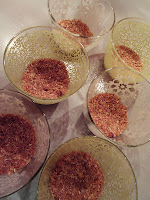Here's a sunshine recipe. 'What is a sunshine recipe?' I hear you ask quite sensibly.
For me, a sunshine recipe is a meal that you make using ingredients or flavours that take you back to a sunny, summer day somewhere in the past.
This recipe did this for me - the sweet, juicy, yellow pineapple and the spicy, colourful dressing reminded me of a hot, sunny day in Queensland - my home State in Australia. Of lazy weekends mowing the lawn, thunder storms, being all sweaty and jumping into the pool for a dip, of bbqs and a cold glass of wine. Fairly remarkable that one little pineapple can do all that!
Anyway, enough reminiscing about times past. Onto the recipe for a stack of pork steaks and grilled pineapple, with a few prawns on top and a chilli and lemongrass dressing. This was just the dish for a cold and snowy evening in the depths of winter in Vienna.
The pineapple provided the inspiration and the ingredients in the fridge and freezer did the rest. Oh the beauty of having a well-stocked fridge with lots of different ingredients to choose from. It is great when you don't have to trek out in the snow to the shops at the last minute.
What you'll need
Served two people.
2 pork steaks or fillet, approximately 150g each
4 pineapple slices (preferably with the core in tact)
4 large green prawns, peeled
Olive oil for grilling the meat and pineapple
Salt and pepper for seasoning
For the dressing
Juice and zest of one lime
1 red chilli, chopped finely
1 tablespoon sweet chill sauce
1 dessert spoon honey
1 teaspoon fish sauce
Good pinch salt
1 small stalk of lemongrass, bruised and the fleshy bottom part chopped finely
Handful fresh basil or mint leaves, stalks removed and chopped finely
To serve
Lime and ripe avocado slices
What to do
Make the dressing. Add all the dressing ingredients into a small bowl and mix well to combine. Set aside.
Heat two frying pans over medium heat. Add a little oil to each. Grill the pork steaks in one pan, until cooked to your liking. I like my pork a little pink in the middle, so about 8 minutes cooking time altogether. Season well with some salt and pepper.
At the same time as the pork is cooking, add the pineapple pieces to the other pan and grill until caramelized on both sides. This will take about 6 minutes.
Once pork and pineapple is cooked, set aside to rest for a few minutes.
Keep the pineapple pan heated and throw in the prawns. Cook for two minutes until just cooked. Remove from the pan and set aside.
Now assemble the dish. Slice each pork steak in half horizontally (so you end up with four thinner pork steaks).
On a large plate, place one pineapple slice. Place one of the pork steaks on top, then repeat with one more pineapple slice and steak. Place two prawns on top, then spoon as much dressing as you like over the whole dish. Place the sliced avocado on the side with a piece of lime and serve immediately.
We ate this with a crunchy cabbage and snow pea salad. It would have been lovely with a glass of crisp, white wine, but it was a tad cold for that. Enjoy your little taste of sunshine.
 Heat a large frying pan over medium heat with a tablespoon of olive oil.
Heat a large frying pan over medium heat with a tablespoon of olive oil.






























